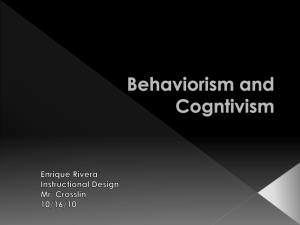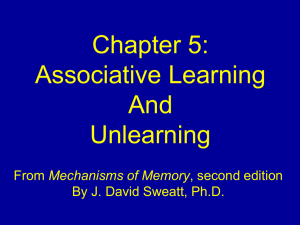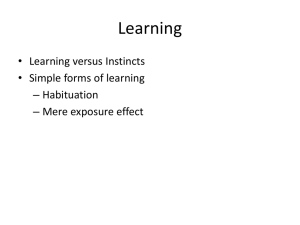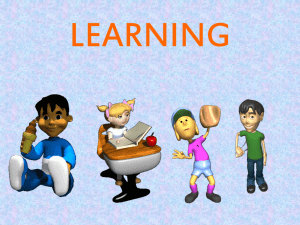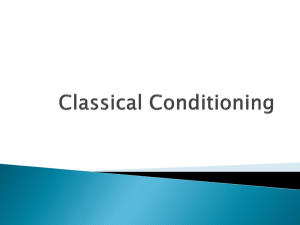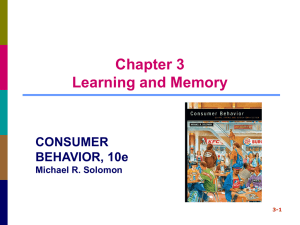File - Danielle Moore Psych Class
advertisement
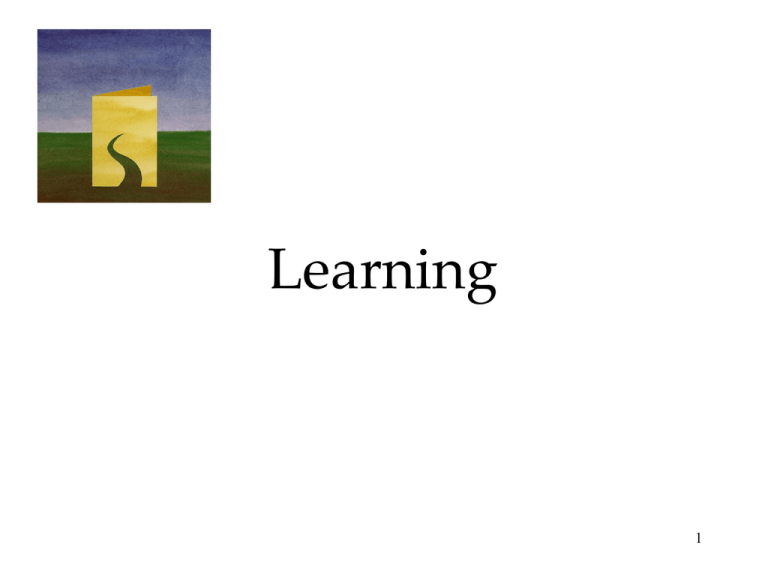
Learning 1 Definition Learning is a relatively permanent change in an organism’s behavior due to experience. Learning is more flexible in comparison to the genetically-programmed behaviors of Salmon, for example. 2 How Do We Learn? We learn by association. Our minds naturally connect events that occur in sequence. 2000 years ago, Aristotle suggested this law of association. Then 200 years ago Locke and Hume reiterated this law. 3 Stimulus-Stimulus Learning Learning to associate one stimulus with another. 4 Response-Consequence Learning Learning to associate a response with a consequence. 5 Response-Consequence Learning Learning to associate a response with a consequence. 6 Stimulus-Stimulus Learning Learning to associate one stimulus with another. 7 8 On your own paper, respond to the following questions and turn them in today: • Can you remember some example from your childhood of learning through classical conditioning? Perhaps salivating at the sound or smell of some delicious food cooking in your family kitchen? • Can you remember and example of operant conditioning, when you repeated (or decided not to repeat) a behavior because you liked or hated its consequence? Can you recall watching someone else perform some act and later repeating or avoiding that act? 9 Classical Conditioning Sovfoto Ideas of classical conditioning originate from old philosophical theories. However, it was the Russian physiologist Ivan Pavlov who elucidated classical conditioning. His work provided a basis for later behaviorists like John Watson and B. F. Skinner. Ivan Pavlov (1849-1936) 10 Pavlov’s Experiments Before conditioning, food (Unconditioned Stimulus, US) produces salivation (Unconditioned Response, UR). However, the tone (neutral stimulus) does not. 11 Pavlov’s Experiments During conditioning, the neutral stimulus (tone) and the US (food) are paired, resulting in salivation (UR). After conditioning, the neutral stimulus (now Conditioned Stimulus, CS) elicits salivation (now Conditioned Response, CR) 12 Directions: Rest for two minutes. Take pulse for 30 seconds Pulse rate: ____x 2= ___ Tap Pencil 5 times Participant hops on one foot for 30 seconds. Record pulse rate at the end of the hoping. Repeat 5 times. After the fifth time, tap the pencil 5 times and immediately record the pulse rate (participant does not hop first). 13 Make your paper look like this: You measure the heart rate for 30 seconds, and multiple it by 2* Resting for one minute. Measure heart rate ___x 2=___ 1) Tap Pencil. Hop 30 sec. Heart rate ___ x2 =_____ Wait 30 sec. 2) Tap Pencil. Hop 30 sec. Heart rate ___ x2 =_____ Wait 30 sec. 3) Tap Pencil. Hop 30 sec. Heart rate ___ x2 =_____ Wait 30 sec. 4) Tap Pencil. Hop 30 sec. Heart rate ___ x2 =_____ Wait 30 sec. 5) Tap Pencil. Hop 30 sec Heart rate ___ x2 =_____ Wait 30 sec. 6) Tap Pencil. DO NOT HOP Heart rate ___ x2 =_____ 14 • Complete the classical conditioning worksheets on your own paper, and turn them in today. • Unconditioned Stimulus (UCS): A stimulus that automatically and naturally triggers a response. • Unconditioned Response (UCR): A unlearned, naturally occurring response to the unconditioned stimulus, like salivation in the dog when food is in the mouth. • Conditioned Stimulus (CS): Originally a neutral stimulus that, after association with an unconditioned stimulus, comes to trigger a conditioned response. • Conditioned Response (CR): A learned response to a previously neutral conditioned stimulus. 15 Classical Conditioning Presentations • You will be assigned a certain section of your text and provided a list of questions to answer from the information found in your text. • Answer each of the questions, and create a presentation to convey the information to your classmates. • One the presentation include: – The facts that you obtained from answering each of the questions on your worksheet. – At least one picture • You have 40 minutes to COMPLETE this activity. • ALL members of your group must participate. I will be observing the room to assess for participation and in-class work grades will be given in accordance with my observations. • Presentations of the information will be today Acquisition Acquisition is the initial stage in classical conditioning in which an association between a neutral stimulus and an unconditioned stimulus takes place. 1. In most cases, for conditioning to occur, the neutral stimulus needs to come before the unconditioned stimulus. 2. The time in between the two stimuli should be about half a second. 17 Acquisition The CS needs to come half a second before the US for acquisition to occur. 18 Extinction When the US (food) does not follow the CS (tone), CR (salivation) begins to decrease and eventually causes extinction. 19 Spontaneous Recovery After a rest period, an extinguished CR (salivation) spontaneously recovers, but if the CS (tone) persists alone, the CR becomes extinct again. 20 Stimulus Generalization Tendency to respond to stimuli similar to the CS is called generalization. Pavlov conditioned the dog’s salivation (CR) by using miniature vibrators (CS) on the thigh. When he subsequently stimulated other parts of the dog’s body, salivation dropped. 21 Stimulus Discrimination Discrimination is the learned ability to distinguish between a conditioned stimulus and other stimuli that do not signal an unconditioned stimulus. 22 https://youtu.be/yJulnBmHtjQ (4:31) classical conditioning video 23 Extending Pavlov’s Understanding Pavlov and Watson considered consciousness, or mind, unfit for the scientific study of psychology. However, they underestimated the importance of cognitive processes and biological constraints. 24 Cognitive Processes Early behaviorists believed that learned behaviors of various animals could be reduced to mindless mechanisms. However, later behaviorists suggested that animals learn the predictability of a stimulus, meaning they learn expectancy or awareness of a stimulus (Rescorla, 1988). 25 Biological Predispositions Pavlov and Watson believed that laws of learning were similar for all animals. Therefore, a pigeon and a person do not differ in their learning. However, behaviorists later suggested that learning is constrained by an animal’s biology. 26 Biological Predispositions Courtesy of John Garcia Garcia showed that the duration between the CS and the US may be long (hours), but yet result in conditioning. A biologically adaptive CS (taste) led to conditioning and not to others (light or sound). John Garcia 27 Biological Predispositions Even humans can develop classically to conditioned nausea. 28 Pavlov’s Legacy Pavlov’s greatest contribution to psychology is isolating elementary behaviors from more complex ones through objective scientific procedures. Ivan Pavlov (1849-1936) 29 • Little Albert • https://www.youtube.com/watch?v=Xt0ucx OrPQE (2:35) 30 Treatment of Phobias 31 Uses for ranchers 32 Psychoneuroimmunology 33 As a joke • http://youtu.be/2c4_l2oe22U (1:10) 34 Applications of Classical Conditioning Brown Brothers Watson used classical conditioning procedures to develop parenting strategies and advertising campaigns for a number of organizations, including Maxwell House, making the “coffee break” an American custom. John B. Watson 35 Operant & Classical Conditioning 1. Classical conditioning forms associations between stimuli (CS and US). Operant conditioning, on the other hand, forms an association between behaviors and the resulting events. 36 Operant & Classical Conditioning 2. Classical conditioning involves respondent behavior that occurs as an automatic response to a certain stimulus. Operant conditioning involves operant behavior, a behavior that operates on the environment, producing rewarding or punishing stimuli. 37 Skinner’s Experiments Skinner’s experiments extend Thorndike’s thinking, especially his law of effect. This law states that rewarded behavior is likely to occur again. Yale University Library 38 law of effect • https://www.youtube.com/watch?v=BDujD OLre-8#action=share (2:21) 39 Using Thorndike's law of effect as a starting point, Skinner developed the Operant chamber, or the Skinner box, to study operant conditioning. Walter Dawn/ Photo Researchers, Inc. 40 From The Essentials of Conditioning and Learning, 3rd Edition by Michael P. Domjan, 2005. Used with permission by Thomson Learning, Wadsworth Division Operant Chamber Skinner Conditioning • https://www.youtube.com/watch?v=TtfQlk GwE2U (1:21) 41 Operant Chamber The operant chamber, or Skinner box, comes with a bar or key that an animal manipulates to obtain a reinforcer like food or water. The bar or key is connected to devices that record the animal’s response. 42 Shaping Shaping is the operant conditioning procedure in which reinforcers guide behavior towards the desired target behavior through successive approximations. Fred Bavendam/ Peter Arnold, Inc. Khamis Ramadhan/ Panapress/ Getty Images A rat shaped to sniff mines. A manatee shaped to discriminate objects of different shapes, colors and sizes. 43 Types of Reinforcers Any event that strengthens the behavior it follows. A heat lamp positively reinforces a meerkat’s behavior in the cold. Reuters/ Corbis 44 Primary & Secondary Reinforcers 1. Primary Reinforcer: An innately reinforcing stimulus like food or drink. 2. Conditioned Reinforcer: A learned reinforcer that gets its reinforcing power through association with the primary reinforcer. 45 Immediate & Delayed Reinforcers 1. Immediate Reinforcer: A reinforcer that occurs instantly after a behavior. A rat gets a food pellet for a bar press. 2. Delayed Reinforcer: A reinforcer that is delayed in time for a certain behavior. A paycheck that comes at the end of a week. We may be inclined to engage in small immediate reinforcers (watching TV) rather than large delayed reinforcers (getting an A in a course) which require consistent study. 46 Reinforcement Schedules 1. Continuous Reinforcement: Reinforces the desired response each time it occurs. 2. Partial Reinforcement: Reinforces a response only part of the time. Though this results in slower acquisition in the beginning, it shows greater resistance to extinction later on. 47 Conditioning • https://youtu.be/qy_mIEnnlF4 (2:45) • https://youtu.be/EWyZHSZf3TM (1:44) 48 Ratio Schedules 1. Fixed-ratio schedule: Reinforces a response only after a specified number of responses. e.g., piecework pay. 2. Variable-ratio schedule: Reinforces a response after an unpredictable number of responses. This is hard to extinguish because of the unpredictability. (e.g., behaviors like gambling, fishing.) 49 Interval Schedules 1. Fixed-interval schedule: Reinforces a response only after a specified time has elapsed. (e.g., preparing for an exam only when the exam draws close.) 2. Variable-interval schedule: Reinforces a response at unpredictable time intervals, which produces slow, steady responses. (e.g., pop quiz.) 50 Schedules of Reinforcement 51 Variable ratio schedule • https://youtu.be/I_ctJqjlrHA (3:57) Punishment An aversive event that decreases the behavior it follows. 53 Punishment Although there may be some justification for occasional punishment (Larzelaere & Baumrind, 2002), it usually leads to negative effects. 1. 2. 3. 4. Results in unwanted fears. Conveys no information to the organism. Justifies pain to others. Causes unwanted behaviors to reappear in its absence. 5. Causes aggression towards the agent. 6. Causes one unwanted behavior to appear in place of another. 54 Negative reinforcement • https://youtu.be/LhI5h5JZi-U (2:30) 55 Extending Skinner’s Understanding Skinner believed in inner thought processes and biological underpinnings, but many psychologists criticize him for discounting them. 56 Cognition & Operant Conditioning Evidence of cognitive processes during operant learning comes from rats during a maze exploration in which they navigate the maze without an obvious reward. Rats seem to develop cognitive maps, or mental representations, of the layout of the maze (environment). 57 Latent Learning Such cognitive maps are based on latent learning, which becomes apparent when an incentive is given (Tolman & Honzik, 1930). 58 Motivation Intrinsic Motivation: The desire to perform a behavior for its own sake. Extrinsic Motivation: The desire to perform a behavior due to promised rewards or threats of punishments. 59 Biological Predisposition Photo: Bob Bailey Biological constraints predispose organisms to learn associations that are naturally adaptive. Breland and Breland (1961) showed that animals drift towards their biologically predisposed instinctive behaviors. Marian Breland Bailey 60 Skinner’s Legacy Skinner argued that behaviors were shaped by external influences instead of inner thoughts and feelings. Critics argued that Skinner dehumanized people by neglecting their free will. Falk/ Photo Researchers, Inc . 61 Applications of Operant Conditioning Skinner introduced the concept of teaching machines that shape learning in small steps and provide reinforcements for correct rewards. LWA-JDL/ Corbis In School 62 Applications of Operant Conditioning Reinforcement principles can enhance athletic performance. In Sports 63 Applications of Operant Conditioning Reinforcers affect productivity. Many companies now allow employees to share profits and participate in company ownership. At work 64 Applications of Operant Conditioning In children, reinforcing good behavior increases the occurrence of these behaviors. Ignoring unwanted behavior decreases their occurrence. 65 Operant vs. Classical Conditioning 66 I am going to a picnic game Learning by Observation © Herb Terrace Higher animals, especially humans, learn through observing and imitating others. ©Herb Terrace The monkey on the right imitates the monkey on the left in touching the pictures in a certain order to obtain a reward. 68 children see children do • https://www.youtube.com/watch?v=KHi2dx Sf9hw (1:32) Reprinted with permission from the American Association for the Advancement of Science, Subiaul et al., Science 305: 407-410 (2004) © 2004 AAAS. Mirror Neurons Neuroscientists discovered mirror neurons in the brains of animals and humans that are active during observational learning. 70 Learning by observation begins early in life. This 14-month-old child imitates the adult on TV in pulling a toy apart. Meltzoff, A.N. (1998). Imitation of televised models by infants. Child Development, 59 1221-1229. Photos Courtesy of A.N. Meltzoff and M. Hanuk. Imitation Onset 71 Bandura's Bobo doll study (1961) indicated that individuals (children) learn through imitating others who receive rewards and punishments. Courtesy of Albert Bandura, Stanford University Bandura's Experiments 72 bandura video • https://www.youtube.com/watch?v=zerCK0 lRjp8 (5:17) Applications of Observational Learning Unfortunately, Bandura’s studies show that antisocial models (family, neighborhood or TV) may have antisocial effects. 74 Positive Observational Learning Bob Daemmrich/ The Image Works Fortunately, prosocial (positive, helpful) models may have prosocial effects. 75 Gentile et al., (2004) shows that children in elementary school who are exposed to violent television, videos, and video games express increased aggression. Ron Chapple/ Taxi/ Getty Images Television and Observational Learning 76 Modeling Violence Children modeling after pro wrestlers Glassman/ The Image Works Bob Daemmrich/ The Image Works Research shows that viewing media violence leads to an increased expression of aggression. 77 Types of learning and the bobo beatdown: • https://www.youtube.com/watch?v=128Ts5r 9NRE (9:34) Observational Learning Article Review • Review the articles provided and summarize the findings. Answer the following questions in your summary: • 1. What is the problem or question's) this research concerns? You should be able to identify the central focus. If there are additional secondary problems, identify these too. (1-4 sentences) 2. What is the source of the data? (That is, questionnaire, intensive interview, documents, existing statistical information, observations, laboratory manipulations, field manipulations, etc.) In some studies there are two or more sources of data. Give a brief overview of how the data were acquired. (2-5 sentences) 3. Briefly, what do the key findings turn out to be? (1-5 sentences) Different Types of Learners • Temple Grandin, diagnosed with autism as a child, talks about how her mind works — sharing her ability to "think in pictures," which helps her solve problems that neurotypical brains might miss. She makes the case that the world needs people on the autism spectrum: visual thinkers, pattern thinkers, verbal thinkers, and all kinds of smart geeky kids. • https://www.ted.com/talks/temple_grandin_the_w orld_needs_all_kinds_of_minds#t-61160 Kinesthetic Learning • Kinesthetic Learning (also known as Tactile Learning) is a learning style in which learning takes place by the student carrying out a physical activity, rather than listening to a lecture or watching a demonstration. People with a preference for kinesthetic learning are also commonly known as "do-ers". Tactile/kinesthetic learners make up about five percent of the population. Visual learning • Visual learning is a teaching and learning style in which ideas, concepts, data, and other information are associated with images and techniques. It is one of the three basic types of learning styles in the widely used Auditory learning • Auditory learning is a learning style in which a person learns through listening. An auditory learner depends on hearing and speaking as a main way of learning. Auditory learners must be able to hear what is being said in order to understand and may have difficulty with instructions that are drawn but if the writing is in a logical order it can be easier to understand . They also use their listening and repeating skills to sort through the information that is sent to them Take Learning Styles Assessment • Total the score for each section. • A score of 21 points or more in a modality indicates a strength in that area. The highest of the 3 scores indicates the most efficient method of information intake. The second highest score indicates the modality which boosts the primary strength. • For example, a score of 23 in visual modality indicates a strong visual learner. Such a learner benefits from the text, from filmstrips, charts, graphs, etc. • If the second highest score is auditory, then the individual would benefit from audio tapes, lectures, etc. • If you are strong kinesthetically, then taking notes and rewriting class notes will reinforce information. Three Types of Learners Visual · Mind sometimes strays during verbal activities · Observe rather than acts or talks · Likes to read · Usually a good speller · Memorizes by seeing graphics or pictures · Not too distractible · Finds verbal instruction difficult · Has good handwriting · Remembers faces · Uses advanced planning · Doodles · Quiet by nature · Meticulous, neat in appearance · Notices details Auditory · Talks to self aloud · Enjoys talking · Easily distracted · Has difficulty with written directions · Likes to be read to · Memorizes sequentially · Enjoys music · Whispers to self while reading · Distracted by noise · Hums or sings · Outgoing by nature Kinesthetic · Likes physical rewards · In motion most of the time · Likes to touch people when talking · Taps pencil or foot when studying · Enjoys doing activities · Reading not a priority · Poor speller · Likes to solve problems by physically working through them · Will try new things · Outgoing by nature; expresses emotions by physical means · Uses hands while talking · Dresses for comfort Toy development • You are a marketing psychologist and you have been hired to design and build a new educational toy. Your new toy will be marketed across the nation this summer. • Your Design Team has 40 minutes to accomplish the following tasks: • 1 – Think of a prototype of a new toy. You will need to decide the following: – – – – • • • • • • • • • • • • • • • What do you want to teach with your toy? What method of learning will your toy use to teach whatever you have decided to teach with the toy? (Classical conditioning, Operant Conditioning, or Observational Learning? What learning style will the toy appeal to? (Visual, Tactile, Kinesthetic?) What age group will the toy be geared towards? 2 – Create a poster-sized magazine ad with the following elements: _____ The name of the new toy your group designed _____ A hand-drawn picture of the toy _____ The price of the toy _____ The name of your Design Team _____ The targeted age for your toy (3-5 years; 6-8 years; 9-11 years; 12+ years) _____ A slogan, jingle, or catch-phrase for your new toy _____ Persuasive comments that would convince parents to purchase the new toy for their child(ren). _____ Remember: your poster should look like a magazine ad and should convince parents to purchase your new toy! 4 – Be prepared to give a 2-3 minute oral presentation to the class, demonstrating your your ad poster. Each member of the team should speak during this presentation.


